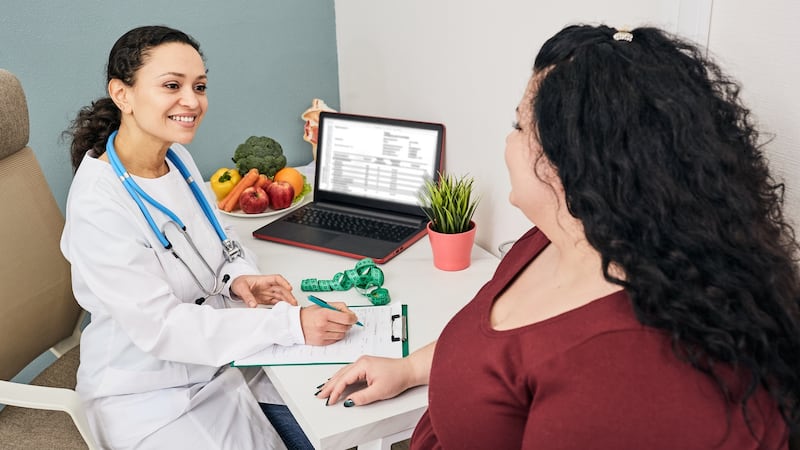Waiting times for a first appointment at the country’s only child and adolescent obesity treatment service have tripled during a surge of referrals since the Covid-19 pandemic, and children are coming in with greater health complications.
"We are completely overwhelmed with demand," says dietitian and researcher Niamh Arthurs, a member of the specialist multidisciplinary team led by Dr Grace O'Malley in Children's Hospital Ireland, at Temple Street. Referrals are up 38 per cent since pre-pandemic levels, she reports, with waiting times stretching to two years and there has been "a 300 per cent rise in children attending our service with very complex, severe stage 3 obesity".
Yet, this lone national service, which sees children as young as two years of age, is funded only part-time. “We’re crying for help. For the Government to wake up,” she says. The longer obesity goes untreated, the more complications a child develops.
Recently released data from England’s child measurement programme has shown the impact of the pandemic there. Some 33.8 per cent of children in the most deprived areas are living with obesity, while in the most affluent areas it is 14.3 per cent. “It is absolutely shocking,” says Arthurs, who believes we have similar trends here in the socio-economic inequity, if not the same collection of data.
Childhood obesity has become a very “buzz word”, she says, but initiatives such as walk to school, the daily mile and healthy lunches, while welcome public health promotion, is not treating children who actually have obesity.
Arthurs is a committee member of the Association for the Study of Obesity on the Island of Ireland (ASOI), which is targeting World Obesity Day on March 4th as a chance to promote greater understanding of the complexities of the illness.
The “eat less, move more” mantra inadvertently perpetuates a misconception that obesity is easily fixed through a change in eating and exercise habits.
In fact, mounting scientific evidence shows how obesity is a brain-related disorder, which has more to do with genetics, our environment and what we were exposed to in the womb, than choices about exercise or food. Ireland has one of the highest levels of obesity in Europe, with 60 per cent of adults and more than one in five children and young people living with overweight and obesity. “If you think treatment is ‘put the child on a diet’, you haven’t a clue about treating childhood obesity,” says Arthurs.

Prejudices persist, even among healthcare professionals and policymakers, against children and adults with excess weight. Whether expressed in thought, word or deed, “fat shaming” exacerbates associated psychological issues.
People tend to think we're just "lazy, stupid, smelly", says Maura Murphy, secretary of the Irish Coalition for People Living with Obesity (ICPO), listing off judgments they face on the basis of their size. The ICPO advocates for members, and their "lived experience" helps to inform healthcare professionals and policy.
The coalition is involved in an ASOI-led collaboration with Obesity Canada, an international leader in evidence-based action to improve the health of people living with obesity. Canadian adult obesity clinical practice guidelines are being adapted for implementation in the Irish healthcare system.
"One of the big changes and key principles of the new approach is diagnosing obesity as a complex, progressive, relapsing, chronic disease that is not based on body weight or size alone," says dietitian Dr Cathy Breen, also a committee member of the ASOI, which is working with the National Clinical Programme for Obesity on the new guidelines. Obesity is an illness now defined as "excess body fat that impairs health", rather than a body size represented by a figure on the Body Mass Index (BMI).
BMI should really be used only for population-based studies, or possibly in general screening for obesity, she says. “But it is not good for assessing health on an individual basis at all.”
Instead of BMI, Canadian experts have developed a much broader assessment tool, the Edmonton Obesity Staging System (EOSS). It considers the functional, metabolic, psychological and monetary complications of obesity.
Rather than classing obesity on the basis of weight, it focuses on the health complications the person may – or may not – have. It poses the fundamental question of how is obesity affecting an individual’s life.
“It’s a much deeper dive into some of the drivers of obesity,” says Breen, who hopes the use of EOSS will “shift the focus of management towards those health outcomes, rather than weight loss alone”. For example, if mobility or physical functioning is severely affected, that would be the focus of interventions.
“A real mind shift for healthcare professionals and the public as well,” she says. Whether you are a surgeon trying to figure out what surgery might be best for a person with obesity, a dietitian looking at nutrition interventions or a physio looking at mobility, the new tool “gives a really good picture of where the person is at with their health, no matter what level of intervention you are looking at”.

Obesity Canada, believing its guidelines could fundamentally change the way healthcare professionals, people living with obesity and policymakers understand and treat obesity, chose Ireland as the sole European representative, along with Chile from South America, for a pilot project in adapting them for use in other countries. A 60-strong team here, ranging from clinicians and specialists in the area of obesity to academics and people living with obesity, are working on how to incorporate them into healthcare.
The project comes at a good time for Ireland, with the launch last year of the HSE’s new model of care for the management of overweight and obesity. It is a real opportunity, says Breen, to introduce high-quality clinical guidelines to inform good practice among all staff in new services.
If you have a genetic susceptibility to weight gain, it will be much more difficult for you to manage your weight gain than somebody who doesn't have that genetic susceptibility
Once the adaptation is complete, there will be webinars for various health workers’ professional bodies, to upskill practitioners in using the new assessment tool, as well as educating them on interventions such as nutrition, activity, medications and bariatric surgery.
Genetic and environmental factors have combined to cause rising obesity rates worldwide. Our so-called “obsegenic” environment, in which higher calorie foods tend to be cheap and available at every turn, is unhelpful in weight management for all of us, Breen says. As is the sedentary nature of most modern-day jobs and over-reliance on passive transport.
“In that environment, if you have a genetic susceptibility to weight gain, it will be much more difficult for you to manage your weight gain than somebody who doesn’t have that genetic susceptibility.”
Research now shows, says Arthurs, that “people have certain genes that can be switched on and switched off by various triggers in the environment”. Those triggers can include stressors that happen as part of the life course, she explains, things we can’t control, such as a pandemic. Some of these genes appear to affect appetite, meaning one person can be satisfied after a certain amount of food while others need a lot more to get the same satisfaction.
There is no cure for obesity, which is “a difficult and unpalatable message for some”, says Breen. “We have some treatments that work relatively well. Behavioural interventions will work to some degree; we have medications and there is bariatric surgery.”
She describes the HSE’s new model of care as a really positive move, “but the next step is resourcing it”. Stigma and weight bias continue to hamper treatment of obesity.
“Sometimes when you are engaging with policymakers and talking about treatments and interventions, they hold the view, why not just ‘eat less and move more’.” The lack of availability of surgery is a good example of that, she suggests, and also the way helpful medications are not reimbursed in the same way as, say, diabetes medications.
Waiting times run into years at the two publicly funded centres for bariatric surgery – Loughlinstown/St Vincent’s in Dublin and in Galway. But the new model of care does envisage setting up more centres across the country.
People living with overweight or obesity may internalise public misinformation, which can have very negative health consequences. “If your understanding of the disease is that ‘I should just be able to manage this’, you would be less likely to talk to a health professional about it,” Breen says. If they do seek help, they may not be dealt with very well by a health professional.
Bias and inadequacies on this front will be tackled as part of the training around the new guidelines.
Read: ‘I was passed over for promotion because I wasn’t front-office material’










